You’re at an estate sale, and there in the corner sits a box of dusty Fiesta dinnerware. Most pieces are common yellow and white, but wait.
Is that medium green? Or could it possibly be the ultra-rare original ivory? Your heart races because the difference between an affordable plate and a premium-priced treasure comes down to correctly identifying rare shades.
The challenge facing every Fiesta collector is that not all discontinued colors are rare, and not all rare colors are valuable.
Some discontinued Fiesta dinnerware colors were produced for decades and remain relatively common on the secondary market.
Others, made for just a year or two, have become genuine treasures commanding premium prices.
Complicating matters further, similar-looking shades from different eras can be easily confused, mistaking modern white for original ivory, or lemongrass for vintage chartreuse, which can mean the difference between a smart purchase and an expensive mistake.
This comprehensive guide reveals Fiesta’s rarest and most valuable discontinued colors, explains what makes certain shades truly scarce, and teaches you how to identify these treasures, whether you’re hunting estate sales or building an investment-worthy collection.
You’ll learn which colors to pursue, which pieces command the highest premiums, and how to authenticate rare finds with confidence.
Understanding Rarity: Not All Discontinued Colors Are Rare
The first critical lesson for any serious Fiesta collector: discontinued does not automatically mean rare or valuable.
This distinction separates knowledgeable collectors from novices who overpay for common pieces.
What Makes a Fiesta Color Truly Rare
Several factors contribute to genuine rarity in Fiesta colors:
Short Production Runs: Colors manufactured for only one to three years exist in far smaller quantities than those produced for decades.
A color made for two years will always be scarcer than one produced for fifteen years, even if both are discontinued.
Limited Distribution: Retailer-exclusive colors sold only through specific stores had restricted availability from the start.
These limited editions, often produced in smaller quantities, automatically become rare when production ends.
Low Initial Production Volumes: Some colors simply weren’t popular during their production years, resulting in fewer pieces manufactured.
Ironically, the colors consumers didn’t love in the 1950s often become the treasures collectors hunt today.
High Attrition Rate: Certain glazes, particularly lighter colors like ivory and light green, show stains, crazing, and wear more readily.
Over the decades, many pieces were discarded or damaged, reducing the surviving population.
Piece Type Availability: Not every item was manufactured in every color. Some rare colors were only produced in limited piece types, making complete sets nearly impossible to assemble.
Collector Hoarding: When knowledgeable collectors identify a color as special and remove pieces from circulation, market availability drops even further, amplifying perceived rarity.
The Rarity Hierarchy
Understanding where colors fall in the rarity spectrum helps set realistic expectations:
Ultra-Rare: includes original ivory, medium green, and certain 1950s colors in specific serving pieces. These command premium prices and require patience to find.
Very Rare: encompasses most limited edition post-86 colors, short-run exclusives, and Ironstone era colors. These appear infrequently but can be found with dedicated searching.
Moderately Rare: covers colors produced for one to three years, like lilac, sapphire, and marigold. These discontinued Fiesta colors appear regularly on secondary markets at medium to premium prices.
Uncommon: describes five to ten-year production colors such as chartreuse, peacock, and scarlet. While discontinued, enough pieces exist that patient collectors can build sets.
Available: includes long-production colors and current offerings that, while perhaps discontinued, remain easy to find at affordable prices.
The critical insight: rarity drives value only when combined with desirability.
Some rare Fiesta colors command modest prices because collector demand remains low, while more available colors like vintage turquoise maintain premium prices due to intense collector interest.
Understanding this dynamic prevents overpaying for obscure colors nobody actually wants.
The Holy Grails: Ultra-Rare Vintage Fiesta Colors
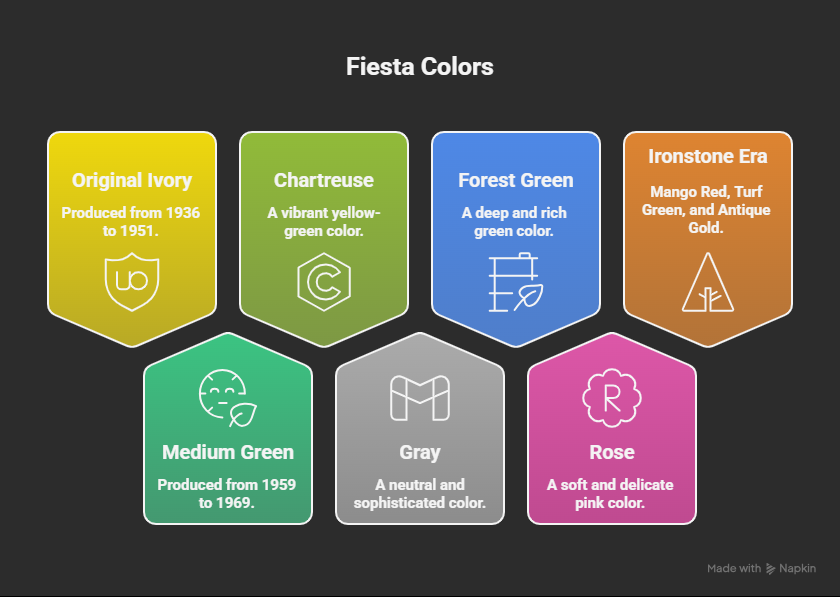
Original Ivory (1936-1951)
Among all discontinued Fiesta dinnerware colors, original ivory ranks as one of the most challenging to find in excellent condition.
Despite a fifteen-year production run as one of the original five colors, ivory has become genuinely scarce for several reasons that illustrate how time affects collectibility.
The cream-colored glaze, while beautiful, proved problematic for everyday use. Ivory showed stains, discoloration, and crazing far more readily than bolder colors.
Over eight decades, countless pieces were discarded when they became too stained or crazed for aesthetic use.
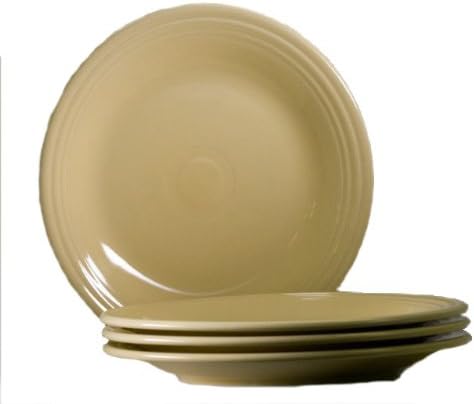
Many homeowners didn’t even realize they owned original ivory, assuming pieces were simply old, dingy white dishes worth nothing, leading to disposal rather than preservation.
Today’s collectors prize original ivory precisely because finding pieces in excellent condition requires dedication.
The warm, cream tone differs distinctly from stark modern white, creating a soft, vintage aesthetic that pairs beautifully with bolder vintage colors.
Backstamp authentication proves essential, as novice sellers frequently mislabel ivory as white or vice versa.
Common ivory pieces command medium to premium prices depending on condition, while rare serving items, coffeepots, marmalade jars, and syrup pitchers reach premium to ultra-premium ranges.
Complete place settings in excellent condition represent significant investments, making ivory the ultimate vintage Fiesta treasure hunt.
Medium Green (1959-1969)
If original ivory is rare due to attrition, medium green is rare due to timing and production volume.
Introduced during the final decade of original Fiesta production, this bright, true green was manufactured for only ten years before Fiesta ceased production entirely in 1973.
The timing proved crucial: by the late 1960s, Fiesta’s popularity had waned considerably.
Production volumes for medium green never matched earlier colors, resulting in fewer pieces from the start.
When Fiesta disappeared from stores in 1973, the brand fell into relative obscurity for over a decade.
During this period, countless medium green pieces were discarded, donated, or broken without recognition of their future value.
Medium green occupies a distinctive position in the Fiesta color spectrum, brighter than light green, truer than forest green, and more vibrant than any other green produced.
This unique shade appeals strongly to collectors seeking vintage colors that remain vivid and fresh-looking despite their age.
Authentication requires careful attention, as medium green is frequently confused with other green shades.
Side-by-side comparison with authenticated pieces proves invaluable, as does backstamp verification. The color appears most distinct in natural daylight, showing its characteristic bright, saturated tone.
Common medium green pieces command premium prices, while rare serving items, particularly teapots, disk pitchers, and covered casserole, reach ultra-premium levels.
Large items like platters in excellent condition represent some of the most valuable vintage Fiesta pieces available.
Collectors pursuing complete medium green sets face a multi-year quest, as finding full place settings in this rare color requires exceptional patience and resources.
The 1950s Color Collection: Chartreuse, Gray, Forest Green, and Rose
The four colors introduced simultaneously in 1951—chartreuse, gray, forest green, and rose—share similar rarity profiles due to their identical eight-year production window (1951-1959).
However, their desirability varies significantly based on aesthetic appeal and current design trends.
Chartreuse
This has emerged as the most sought-after of this quartet, riding the massive mid-century modern revival that has dominated interior design for the past two decades.
This yellow-green shade epitomizes 1950s atomic-age optimism and space-age design. Its bold, almost neon quality makes it instantly recognizable and highly photogenic, crucial in today’s social media-driven collecting culture.
The color’s eight-year production run created moderate scarcity, positioning it in the sweet spot where finding pieces requires effort but isn’t impossible.
Chartreuse works beautifully with gray, white, and turquoise for authentic mid-century aesthetics, driving demand from both serious collectors and interior designers staging period-appropriate spaces.
Common chartreuse pieces typically command medium to premium prices, with rare serving items reaching premium to ultra-premium ranges.
Complete sets represent significant investments, particularly when pieces show minimal wear or crazing.
Gray
Offers sophisticated neutrality that appeals to collectors seeking versatile vintage colors. During its 1950s production, gray wasn’t particularly popular; most consumers preferred brighter, cheerier colors.
This lukewarm reception resulted in lower production volumes compared to more popular colors, creating genuine scarcity decades later.
Today’s collectors appreciate gray for its elegant restraint and mixing versatility. It pairs beautifully with virtually any other Fiesta color while providing visual calm in colorful tablescape settings.
Gray’s understated sophistication has driven steady appreciation in collector interest and pricing.
Forest Green
Provides deep, rich color depth that adds gravitas to vintage collections. This dark, saturated green appeals to collectors seeking traditionally elegant colors rather than bright, playful tones.
While not as universally popular as chartreuse, forest green maintains strong demand among vintage purists.
Rose
Represents the softer end of 1950s Fiesta, offering dusty pink tones that evoke the decade’s pastel aesthetics.
While perhaps less dramatic than chartreuse or gray, rose has maintained steady collector interest due to its romantic, feminine appeal and successful pairing with both neutrals and bolder colors.
All four 1950s colors command medium to premium prices for common pieces, with rare serving items and large pieces reaching premium to ultra-premium levels.
Their shared rarity profile and era-specific appeal make them foundation pieces for any serious vintage Fiesta collection.
The Ironstone Era: Mango Red, Turf Green, and Antique Gold
From 1969 to 1972, Homer Laughlin produced Fiesta on a different body style called Ironstone, creating three colors exclusive to this brief period: mango red, turf green, and antique gold.
These colors represent an interesting rarity case study, extremely short production runs creating genuine scarcity, but limited collector demand due to aesthetic differences.
The Ironstone body differs from the original Fiesta in both weight and feel, and the three colors reflect early 1970s earth-tone trends rather than Fiesta’s typically vibrant palette.
Mango red leans coral, turf green evokes avocado kitchen appliances, and antique gold suggests harvest gold décor, all very 1970s, but not necessarily what collectors seek when hunting vintage Fiesta.
These colors are genuinely rare due to two-to-three-year production windows and low initial popularity. Few pieces survived the 1970s and 1980s when these colors fell completely out of fashion.
However, collector demand remains moderate, resulting in affordable to medium pricing despite scarcity—proof that rarity alone doesn’t guarantee premium values.
Ironstone colors appeal primarily to completist collectors pursuing every Fiesta variation or those specifically collecting 1970s design artifacts.
For most collectors focused on vintage Fiesta’s classic aesthetic, these colors remain interesting footnotes rather than must-have acquisitions.
Limited Edition Treasures: Rare Post-86 Colors
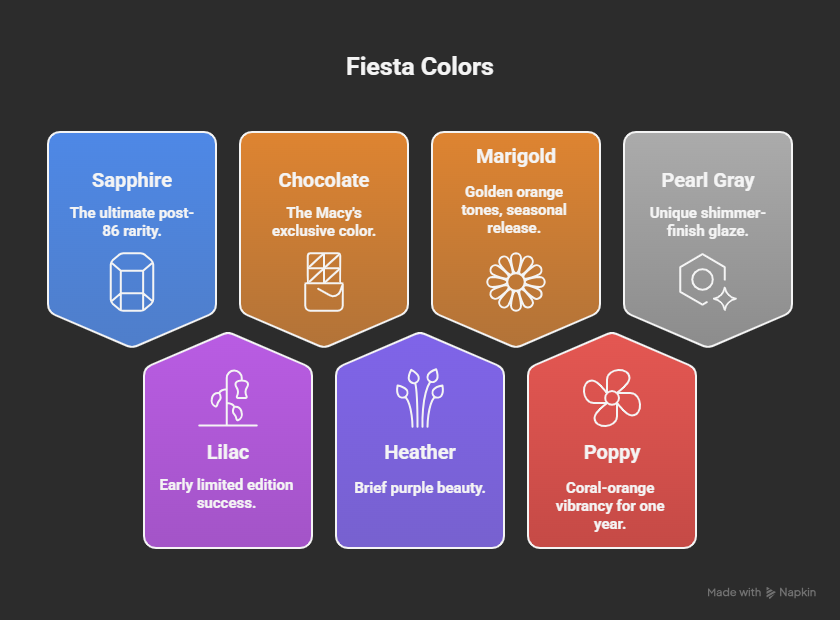
When Homer Laughlin revived Fiesta in 1986, they introduced a strategy of limited edition and retailer-exclusive colors designed to generate collector excitement and drive sales.
This approach created an entirely new category of rare Fiesta colors, modern pieces with intentionally limited availability.
Sapphire (1996-1997): The Ultimate Post-86 Rarity
Among all post-1986 limited editions, sapphire stands alone as the most genuinely rare and valuable.
Produced exclusively for Bloomingdale’s for just a single year, this deep blue-purple was manufactured in limited quantities from the start.
Sapphire’s exceptional rarity stems from perfect storm conditions: exclusive retail distribution, single-year production, stunning color that appealed immediately to collectors, and savvy collectors who recognized its specialness and hoarded pieces.
Unlike some limited editions that languished unsold, sapphire generated immediate demand that has only intensified as pieces become harder to find.
The deep, jewel-toned blue-purple differentiates itself from standard cobalt while maintaining a sophisticated appeal.
Collectors prize sapphire for both its genuine scarcity and its aesthetic beauty, a combination that drives premium to ultra-premium pricing across all piece types.
Complete sapphire sets rarely appear on secondary markets, and when they do, they command prices rivaling some vintage rarities.
Lilac (1993-1995): Early Limited Edition Success
Introduced in 1993 as one of Fiesta’s first post-86 limited editions, lilac established the template for intentionally scarce modern colors.
This soft purple-lavender was produced for approximately two years in limited quantities, creating moderate rarity that has sustained collector interest for three decades.
Lilac appeals to collectors seeking softer, more romantic colors in the typically bold Fiesta palette.
The shade works beautifully with white, rose, and periwinkle for pastel-themed collections, or provides gentle contrast against bolder colors.
Its early limited edition status gives it vintage cachet despite being a modern color, bridging the gap between post-86 and vintage collecting.
Common lilac pieces typically command medium prices, while rare serving items and large pieces reach premium ranges.
Complete sets appear occasionally on secondary markets, usually commanding prices reflecting both scarcity and sustained collector demand.
Chocolate (2006-2008): The Macy’s Exclusive
Produced exclusively for Macy’s, chocolate brought rich brown tones to Fiesta’s palette—a color choice that proved polarizing.
Many collectors loved the sophisticated, neutral-with-personality shade, while others found it too subdued for Fiesta’s traditionally vibrant aesthetic.
This divided opinion resulted in modest initial sales and lower production volumes, creating genuine scarcity.
However, limited demand during production also means limited demand today, resulting in affordable to medium pricing despite rarity.
Chocolate represents an interesting market dynamic: genuinely hard to find, but not commanding premium prices because collector demand remains moderate.
Collectors specifically seeking complete color spectrum coverage or those furnishing chocolate-brown themed interiors prize these pieces.
For most collectors, chocolate remains an interesting oddity rather than an essential acquisition.
Heather (2008-2009): Brief Purple Beauty
Heather’s single-year production created immediate scarcity for this dusty lavender shade.
The color appealed to collectors who found lilac too light or wanted additional purple-family options for their collections.
With limited production quantities and brief availability, heather has become genuinely difficult to find.
Common pieces command medium prices, while rare serving items reach premium levels.
The color appears infrequently on secondary markets, making it a challenging treasure hunt for collectors seeking purple-toned Fiesta.
Other Notable Post-86 Rarities
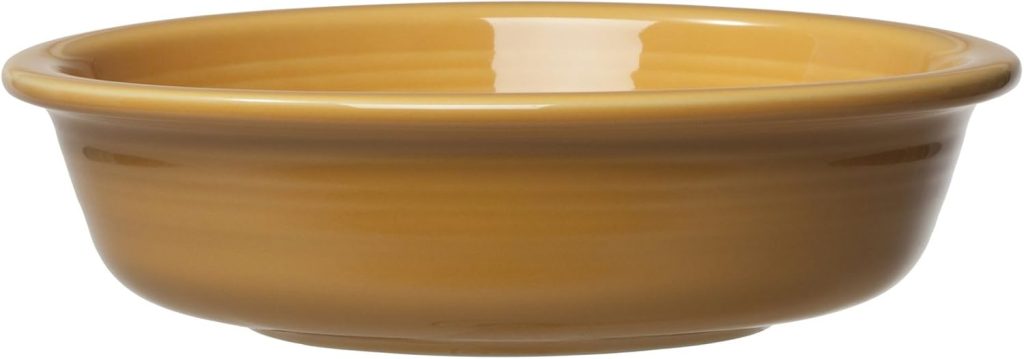
Marigold (2011-2012): brought golden orange tones as a seasonal release, creating limited availability that appeals to collectors seeking warm autumn colors.
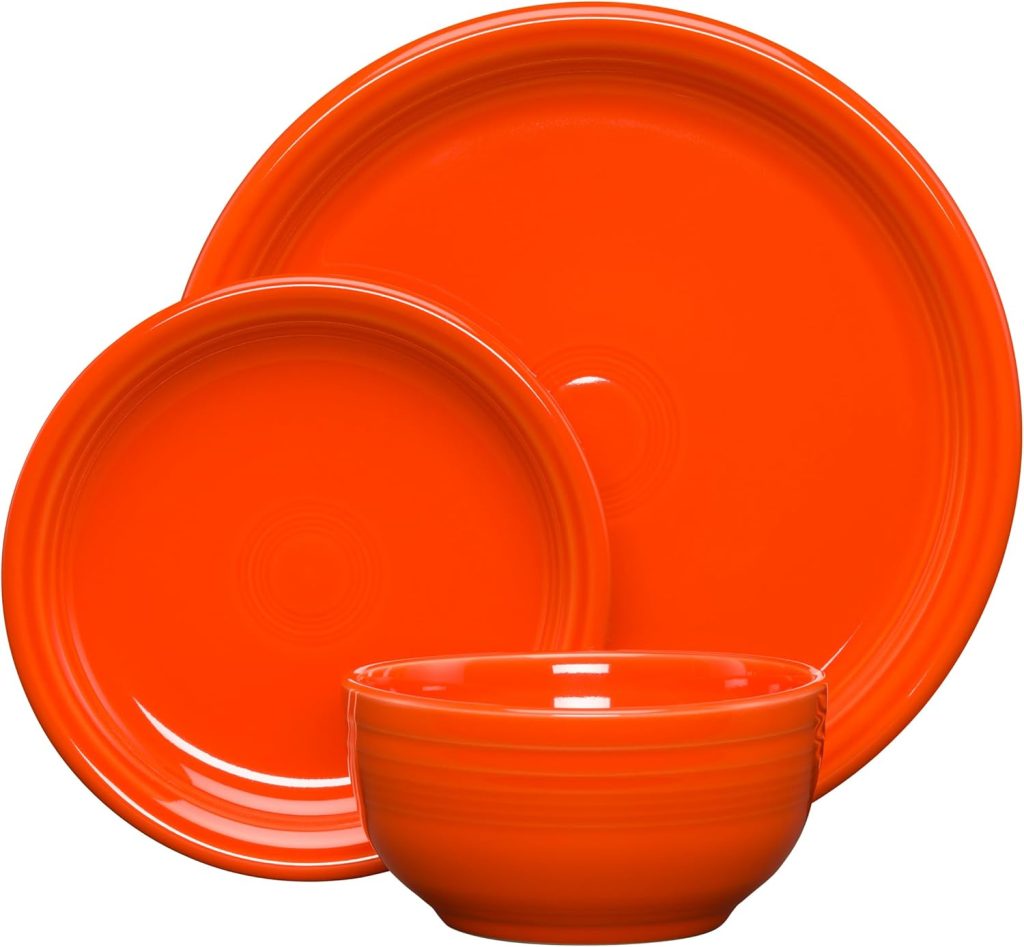
Poppy (2013-2014): offered coral-orange vibrancy for just one year, creating moderate rarity popular with collectors building warm-toned palettes.
Pearl Gray (1999-2001): featured a unique shimmer-finish glaze that differentiated it from standard gray, appealing to collectors seeking unusual finishes.
Each limited edition tells a story of intentional scarcity designed to drive collector interest, a modern approach to creating rare Fiesta colors that contrasts sharply with vintage rarities created by time, attrition, and forgotten history.
The Confusion Colors: Avoiding Costly Misidentification
Perhaps the most dangerous pitfall in hunting rare Fiesta colors involves misidentifying similar shades, a mistake that can result in paying premium prices for common pieces or passing on genuine treasures mistakenly identified as ordinary.
Medium Green vs. Light Green vs. Forest Green
These three vintage greens create endless confusion, yet proper identification proves essential given their dramatically different values.
Medium green commands premium prices due to genuine rarity, while light green and forest green, though valuable, appear more frequently on secondary markets.
Medium green appears brightest and truest, imagine grass-green or kelly-green with slight yellow undertones.
Light green leans minty and pale, clearly softer than medium green. Forest green shows deep, dark saturation with blue undertones.
Side-by-side comparison makes differences obvious, but in isolation, identification becomes challenging.
Backstamp dating provides the ultimate authentication: light green appears on vintage pre-1951 backstamps, forest green on 1951-1959 marks, and medium green on 1959-1972 stamps.
When color identification proves ambiguous, backstamp evidence settles the question definitively.
Original Ivory vs. Post-86 White vs. Modern Ivory
This confusion costs collectors dearly, as original ivory commands premium prices while post-86 white remains affordable and readily available.
The colors appear similar enough that poor lighting, faded photographs, or wishful thinking creates frequent misidentification.
Original ivory shows warm, cream tones, think vanilla ice cream or aged white paint. Post-86 white appears stark, cool, and brilliant, think fresh paint or computer-screen white.
The difference becomes obvious in natural daylight with pieces side-by-side, but photographs and indoor lighting can obscure distinctions.
Complicating matters, Homer Laughlin reissued ivory from 2009-2017, creating a modern ivory that closely matches vintage tones.
Only backstamps definitively separate vintage original ivory (premium pricing) from modern post-86 ivory (medium pricing) and white (affordable pricing).
Weight also provides clues that vintage pieces feel slightly heavier due to different clay body composition.
Combined with backstamp verification and color assessment in natural light, accurate identification becomes achievable even for novice collectors.
Vintage Red Variations: Three Different Formulations
Vintage Fiesta red appears in three distinct formulations, each with a different composition, appearance, and value.
Original uranium-glazed red (1936-1943) shows characteristic orange-red tones and remains most valuable.
The brief uranium red variant (1943-1944) appears similar but shows subtle differences. Non-radioactive red (1959-1972) appears truer red with less orange undertone.
Distinguishing these variations requires experience, backstamp dating, and ideally, Geiger counter testing for uranium-glazed versions.
The complexity creates opportunity for misidentification and pricing errors, making expert consultation valuable for significant red purchases.
Chartreuse vs. Lemongrass: Cross-Era Confusion
Vintage chartreuse (1951-1959) and modern lemongrass (2010-present) both occupy yellow-green territory, creating confusion, particularly in online listings with poor photography.
Chartreuse leans more yellow with neon undertones reflecting 1950s aesthetics, while lemongrass shows more green with softer, contemporary tones.
Backstamps again provide definitive identification, separating discontinued vintage chartreuse (medium to premium pricing) from currently-produced lemongrass (affordable pricing).
The price difference makes accurate identification essential when evaluating potential purchases.
For comprehensive guidance on authenticating vintage versus modern Fiesta pieces, including detailed backstamp identification and physical characteristic analysis, consult our complete guide on Identifying Authentic Fiesta Colors (Old vs New).
Rarity by Piece Type: When Common Colors Become Rare Treasures
Understanding that rarity applies not just to colors but also to specific piece types opens new collecting dimensions. Even common colors can command premium prices in certain rare forms.
Extremely Rare Piece Types
Certain items were produced in very limited quantities regardless of color, making them rare even in common shades:
Marmalade jars with lids rank among the most challenging Fiesta pieces to find. The small jars with fitted lids were produced in limited numbers and had high attrition rates due to breakage and lost lids.
Syrup pitchers with their distinctive drip-cut spouts and lids appear infrequently, commanding premium prices even in readily available colors.
Coffeepots, particularly vintage versions, were produced in smaller quantities than everyday items and suffered high breakage rates due to their size and fragility.
French casseroles with their distinctive covered design remain challenging to find, complete with lids.
Tom & Jerry mugs in original vintage colors were produced briefly and in limited quantities, creating genuine scarcity across all colors.
The Rarity Multiplier Effect
When rare colors intersect with rare pieces, values multiply exponentially rather than simply adding.
A medium-priced medium green dinner plate becomes an ultra-premium medium green coffeepot.
An affordable chartreuse cup becomes a premium chartreuse marmalade jar.
This multiplier effect creates the highest-value Fiesta items: medium green coffeepots, chartreuse marmalades, original ivory syrup pitchers, and sapphire serving pieces command ultra-premium prices that exceed most collectors’ budgets.
These pieces represent the summit of Fiesta, collecting rare color in rare form.
Collecting Strategy: Rare Pieces vs. Rare Colors
Some collectors focus on acquiring common colors in rare piece types rather than rare colors in common pieces.
Both approaches offer satisfaction and investment potential, but represent different philosophies.
Rare piece collectors might pursue vintage coffeepots in every color, or build a collection of marmalade jars across the color spectrum.
This strategy creates striking, cohesive displays and often proves more affordable than collecting rare colors, as common-color rare pieces typically cost less than rare-color common pieces.
Rare color collectors focus on acquiring discontinued colors in standard pieces, dinner plates, cups, bowls, and building complete sets in scarce shades.
This approach emphasizes color completion and creates usable collections, though acquiring rare serving pieces in rare colors may prove cost-prohibitive.
Both strategies represent valid approaches to building significant Fiesta collections. The choice depends on personal preference, budget, and whether you prioritize color spectrum coverage or piece-type variety.
Where to Find Discontinued Fiesta Colors
Knowing which rare Fiesta colors to pursue means nothing without understanding where to find them. Different sources offer distinct advantages and challenges for treasure hunting.
Estate Sales: The Prime Hunting Ground
Estate sales consistently offer the best opportunity for finding rare vintage Fiesta at favorable prices.
When long-time homeowners’ possessions reach the market, often after decades in cupboards, rare colors surface from obscurity.
The key advantage: estate sale organizers frequently lack specialized Fiesta knowledge, resulting in underpricing based on general vintage dinnerware values rather than specific color rarity.
A medium green plate might be priced identically to a common yellow, creating opportunities for knowledgeable collectors.
Successful estate sale hunting requires arriving early, ideally for preview hours when serious collectors get first pick.
Target sales in neighborhoods with older demographics, where vintage Fiesta was more likely to be purchased originally and retained for decades.
Sales advertising “vintage kitchen” or “mid-century items” deserve priority attention.
Antique Malls: Consistent Supply with Variable Pricing
Antique malls offer year-round availability and the crucial advantage of in-person inspection before purchase.
Quality assessment checking for chips, cracks, crazing, and color authenticity proves far easier when handling actual pieces rather than evaluating photographs.
Pricing varies dramatically based on dealer knowledge. Generalist dealers often price Fiesta based on age and condition without considering color rarity, creating opportunities.
Specialist dealers who know Fiesta intimately typically price accurately but fairly, making their booths reliable sources for authenticated rare colors at market-appropriate levels.
Building relationships with booth owners yields benefits; dealers remember collectors seeking specific colors and may contact you when pieces arrive.
Regular visits to antique malls reveal newly-stocked inventory before other collectors discover it.
Online Marketplaces: Volume with Vigilance Required
eBay provides the largest selection of rare Fiesta colors, with hundreds of listings representing decades of production.
The sheer volume means rare colors appear regularly, but competition and awareness of values result in premium pricing.
Successful eBay collecting requires patience and discipline. Save searches for specific rare colors, check completed listings to understand actual selling prices versus asking prices, and set maximum bids reflecting true value rather than auction excitement.
Remember that online purchases lack in-person inspection, requiring careful photo analysis and seller communication to verify condition.
Etsy often offers better pricing than eBay, particularly from sellers clearing estates or downsizing collections.
The platform’s community feel sometimes results in more reasonable pricing and better seller communication.
Facebook Marketplace and Craigslist provide the lowest prices and occasional stunning finds from sellers who simply want to clear space.
Local pickup eliminates shipping concerns and allows in-person inspection. However, these platforms require daily checking and quick response, as truly underpriced rarities disappear within hours.
Auction Houses: Where True Rarities Surface
Major auction houses specializing in ceramics and vintage housewares occasionally feature significant Fiesta collections, including ultra-rare colors and pieces.
While buyers’ premiums increase total costs, auctions establish true market values and attract pieces too valuable or rare for typical secondary markets.
Serious collectors pursuing ultra-rare items, medium green coffeepots, original ivory serving pieces, and complete chartreuse sets should monitor specialty auction houses for opportunities to acquire treasures rarely seen elsewhere.
Collector Forums and Private Sales
Private sales within Fiesta collector communities offer the advantages of authenticated pieces, fair pricing based on collector knowledge, and direct communication about condition and history.
Many serious collectors prefer buying from and selling to other collectors, creating a parallel market separate from public platforms.
Joining Fiesta collector groups, both online forums and local clubs, provides access to these private markets and invaluable knowledge exchange about identifying, authenticating, and valuing rare colors.
Building Your Rare Color Collection
Pursuing discontinued Fiesta dinnerware colors requires strategy, patience, and realistic expectations about timelines and investment.
The Completist Approach
Collectors pursuing every rare Fiesta color embark on a multi-year or even decade-long quest requiring significant resources.
This comprehensive approach demands dedication to authentication, condition standards, and systematic acquisition.
Completists typically prioritize rare colors first, recognizing that common colors remain readily available while rare shades require seizing opportunities when they appear.
Building spreadsheets tracking needed pieces, setting price alerts, and maintaining acquisition budgets help manage the complex, long-term process.
The Era Specialist Strategy
Focusing on specific periods—1950s colors exclusively, or post-86 limited editions creates achievable completion goals while developing deep expertise in chosen eras.
Era specialists become authorities on their specific timeframe, recognizing subtle variations and authentication markers that generalists might miss.
This focused approach typically proves more affordable than completist collecting while still offering the satisfaction of comprehensive coverage within defined parameters.
The Investment Collector Philosophy
Investment-focused collectors prioritize appreciation potential over personal color preferences, strategically acquiring discontinued colors likely to increase in value.
This approach requires market research, tracking price trends, and disciplined purchasing focused on condition and authenticity.
Investment collectors often maintain pieces in storage rather than using them, preserving their mint condition that maximizes resale value.
Documentation of purchases—dates, sources, prices paid—supports potential future sales and insurance claims.
The Opportunistic Treasure Hunter
Perhaps the most enjoyable approach involves buying rare Fiesta colors as opportunities arise without rigid completion goals.
Opportunistic collectors embrace serendipity, finding medium green at estate sales, stumbling on sapphire at antique malls, and discovering chartreuse at reasonable prices.
This flexible approach removes pressure while maintaining excitement.
Each find represents genuine discovery rather than systematic acquisition, keeping the hobby fun rather than feeling like work.
Smart Collecting Practices Across All Approaches
Regardless of strategy, certain principles guide successful rare color collecting:
Prioritize condition relentlessly: Rare colors in poor condition, chips, cracks, significant crazing, and staining rarely prove worthwhile investments. Better to wait for excellent examples than settle for damaged pieces.
Authenticate rigorously: Never assume rare colors are authentic without verification.
Check backstamps, compare colors to authenticated examples, consult experts when necessary, and walk away from questionable pieces regardless of pricing.
Document systematically: Photograph acquisitions, record purchase details, and maintain insurance documentation.
As collections grow, memory fades, systematic documentation prevents forgotten details, and supports insurance claims if necessary.
Store properly: Rare Fiesta deserves protective storage preventing chips, cracks, and damage. Display valuable pieces safely away from edges where they might fall.
Consider whether display or cabinet storage better preserves your investment.
Research continuously: Markets evolve, new information surfaces, and values shift. Successful collectors stay informed through forums, price guides, auction results, and community engagement.
Conclusion: The Thrill of the Hunt
The pursuit of discontinued Fiesta colors and rare shades represents peak collecting excitement, the possibility that any estate sale might hide medium green, any antique mall booth could yield sapphire, and any online listing might offer chartreuse at favorable pricing.
These rare colors tell stories of design evolution, production decisions, and survival against odds, making each authenticated piece not just dinnerware but rescued history.
Understanding what makes Fiesta colors truly rare, distinguishing genuine scarcity from simple discontinuation, transforms collectors from casual browsers into informed treasure hunters.
The rarest pieces combine limited production, high desirability, and survival scarcity, creating perfect conditions for both investment appreciation and collecting satisfaction.
Whether you’re pursuing ultra-rare vintage ivory, coveted medium green, limited edition sapphire, or any of the sought-after 1950s colors, remember that the hunt itself provides as much joy as the acquisition.
The discontinued colors that once faced potential oblivion now command premium prices and passionate collector devotion.
In collecting rare Fiesta colors, you’re not just acquiring vintage dinnerware; you’re becoming a curator of American design history, one colorful treasure at a time.
For those seeking to understand how these rare discontinued colors fit within Fiesta’s complete color evolution, our comprehensive timeline on Fiesta Colors Guide provides essential context.
And to discover which rare shades have achieved the most passionate collector followings, explore the Most Popular Fiesta Colors for insights into what drives lasting desirability beyond mere scarcity.